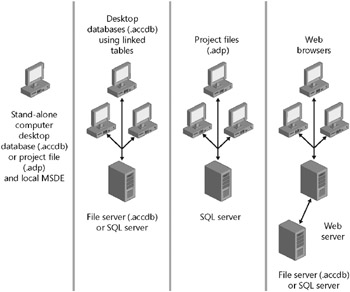The Many Faces of Access
Access is not only a powerful, flexible, and easy-to-use database management system, but it is also a complete database application development facility. You can use Access to create and run, under the Windows operating system, an application tailored to your data management needs. Access lets you limit, select, and total your data by using queries. You can create forms for viewing and changing your data. You can also use Access to create simple or complex reports. Forms and reports inherit the properties of the underlying table or query, so in most cases you need to define such properties as formats and validation rules only once. Figure 3–36 gives you an overview of all the ways you can use Access to implement an application.

Figure 3–36: Although Access is primarily a desktop database system, you can use Access to build client/server applications.
The four sections in the figure illustrate ways you can implement an Access application, as follows:
-
Using the desktop database facility or an Access project file linked to a local copy of MSDE, you can create a stand-alone application used by a single person.
-
You can place a data-only desktop database on a file server or in a database in SQL Server and link the tables over a network to multiple desktop databases so that several users can share the same application.
-
You can design your database in SQL Server and connect to the server over a network from multiple Access project files running on different computers.
-
Finally, you can create Web pages that connect to data that you designed using Access.
To borrow a cliché, the possibilities are endless ...
In this chapter, you’ve had a chance to look at the major objects in the Housing Reservations and Conrad Systems Contacts sample databases. You’ve also been introduced to the architecture of Access and the wide range of ways that you can use Access. You should be feeling comfortable that you can learn to use Access at the level appropriate to solve your database application needs. In the next chapter you’ll learn how to create new databases and the tables you need to store your data.”
EAN: 2147483647
Pages: 234